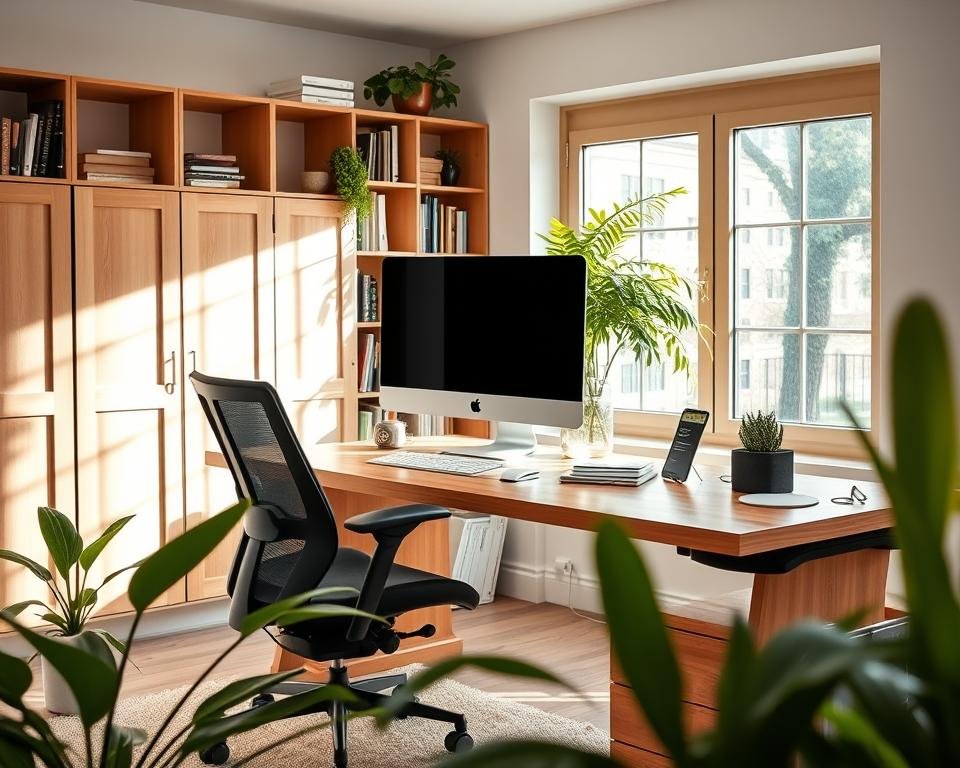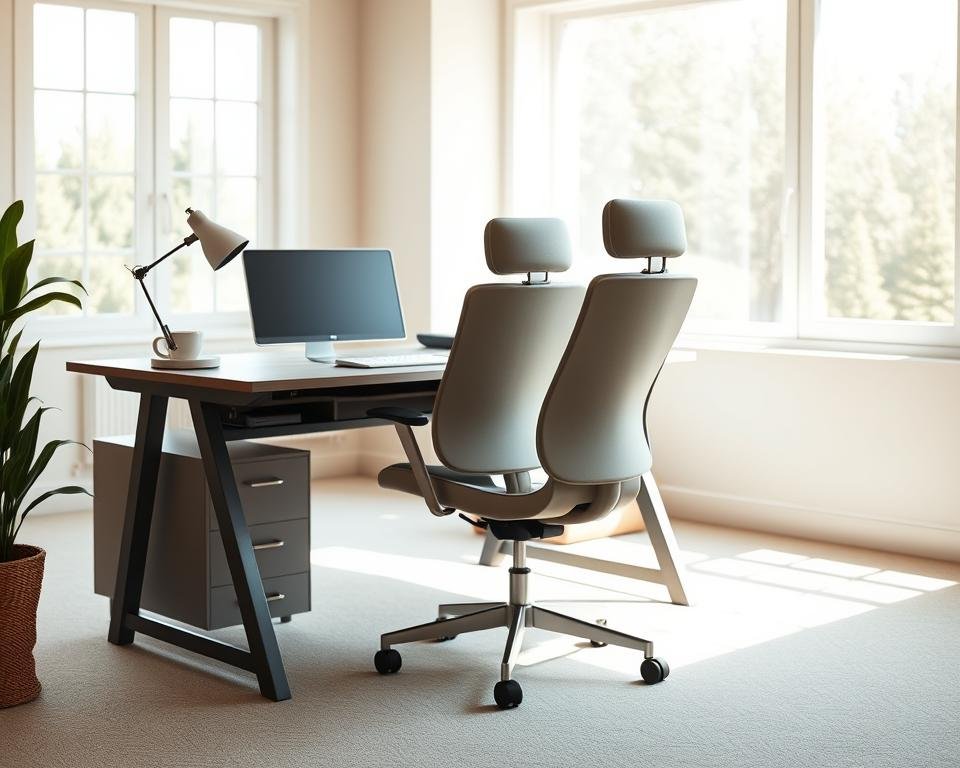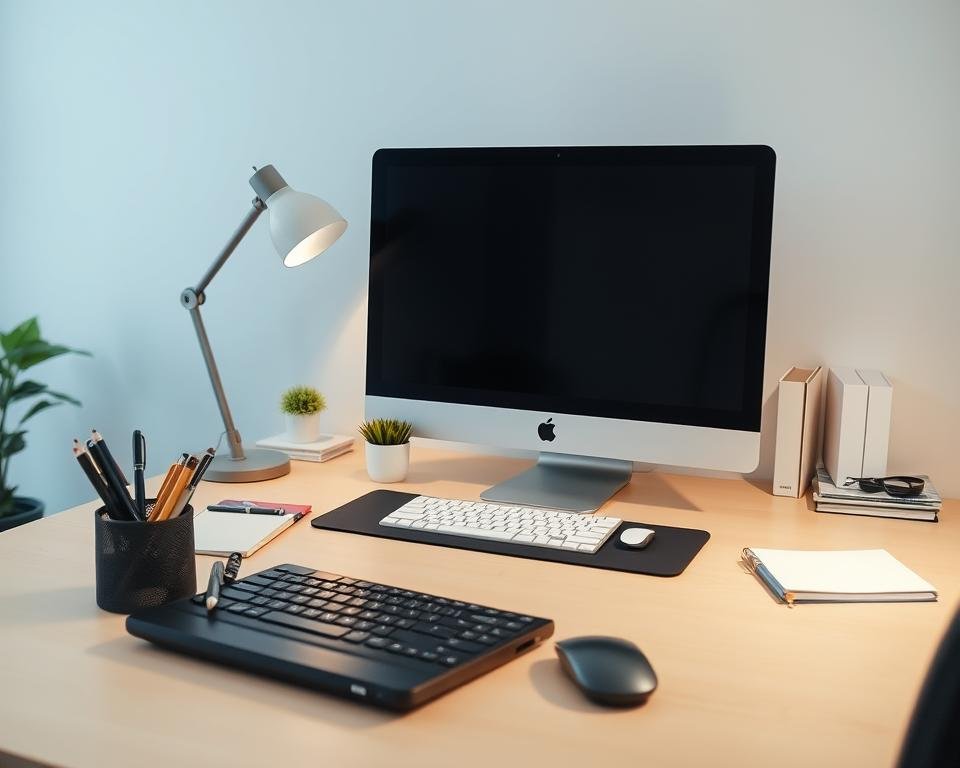“Age is not a barrier to productivity; it’s an opportunity to refine your environment.” – Martha Stewart’s words ring true for those embracing remote work later in life. Creating a workspace that supports your body and mind isn’t just about convenience—it’s about thriving in this new chapter.
Whether you’re starting a consulting gig or managing hobbies online, your physical space matters. A well-designed area reduces fatigue, improves focus, and keeps you energized. The right tools—like an adjustable chair or a clutter-free desk—can make all the difference.
Think about how your body moves throughout the day. Does your seat support your lower back? Can you easily reach your keyboard without straining? Small tweaks, like raising your monitor to eye level, protect posture and prevent aches. Comfort isn’t a luxury—it’s a necessity.
Key Takeaways
- Ergonomic furniture reduces physical strain and boosts productivity.
- Adjustable chair height ensures proper alignment for long hours.
- Spacious desks provide room for computers and essential tools.
- Organized layouts minimize distractions and enhance efficiency.
- Proper lighting and tech placement protect vision and posture.
Understanding Your Home Office Needs
What makes a workspace truly yours? It starts with matching your daily habits to your environment. Think about how you interact with tools, technology, and time—these elements shape your productivity more than you might realize.

Identifying Your Workspace Requirements
Begin by listing essentials—your computer, notebooks, or specialized equipment. Measure your available space to ensure everything fits without crowding. A compact desk with drawers keeps frequently used items within reach while maintaining a clean surface.
Natural light matters more as eyes age. Position your desk near a window but avoid glare on screens. Add adjustable lamps for cloudy days or evening work. Task lighting reduces eye strain better than overhead fixtures.
Setting Boundaries Between Work and Home
Choose a place that signals “work mode” when you enter it. This could be a corner with a room divider or a specific chair. Visual cues help—close a laptop cover or hang a “Do Not Disturb” sign during focused hours.
Schedule breaks to stretch or hydrate, then return to your designated area. Separate devices for personal and professional tasks if possible. Silence non-urgent notifications to maintain mental clarity between roles.
Essential Ergonomic Considerations
Your comfort during work hours hinges on how well your space adapts to you. Smart furniture choices and tech alignment aren’t just trendy—they’re critical for maintaining energy and focus.

Finding Supportive Furniture
Start with a desk chair that hugs your lower back. Look for models with built-in lumbar support to protect your spine. If your current seat lacks this feature, add a cushion designed for posture correction.
Adjustable height settings let you customize both chair and work surface. Feet should rest flat on the floor, with knees forming a 90-degree angle. Armrests? Optional—but if used, they should keep shoulders relaxed.
Positioning Your Tech Tools
Center your monitor at eye level to avoid neck craning. Use risers or stackable books if needed. Keyboards belong at elbow height, allowing wrists to stay straight while typing.
Keep the mouse close to prevent overreaching. Wireless models reduce cable clutter—one less distraction on your desk. For touchscreen devices, position them within natural arm’s reach to limit repetitive motions.
Organize frequently used office supplies in desk trays or wall-mounted holders. This clears workspace real estate while keeping essentials accessible. Remember: less stretching equals fewer aches later.
Home Office Setup Tips for Seniors
Technology should empower, not complicate—choose tools that simplify your workflow. The right gadgets and illumination choices transform your environment from functional to inspiring. Let’s explore how to blend modern convenience with thoughtful design.
Technology and Equipment Essentials
Wireless keyboards reduce cable chaos while offering larger keys for comfortable typing. Pair them with ergonomic mice to minimize wrist strain during long sessions. Consider voice-to-text software if typing feels tedious—it’s like having a digital assistant.
Vertical storage units save desk space. Wall-mounted shelves or rolling carts keep printers and supplies accessible yet out of the way. For tech recommendations tailored to older adults, explore senior-friendly websites that curate easy-to-use devices.
Ensuring Comfortable Lighting and Layout
Position your desk perpendicular to windows to maximize natural light without screen glare. Morning sunlight boosts alertness, while afternoon diffusion creates softer illumination. Add an adjustable desk lamp with warm-white bulbs for evening tasks.
Arrange your keyboard and monitor so they’re directly in front of you. This setup prevents neck twisting and keeps essentials within a 20-inch “comfort zone.” Drawer organizers or desktop trays prevent clutter from invading your work surface—because searching for pens shouldn’t derail productivity.
Organizing Your Space for Efficiency
A streamlined workspace isn’t about perfection—it’s about creating flow. When every item has a purpose and place, you spend less time searching and more time accomplishing. Let’s transform clutter into calm.

Decluttering and Effective Storage Solutions
Start with your desk surface. Remove everything, then return only daily-use supplies. Use drawer dividers for smaller items like sticky notes or charging cables. This “reset” reveals what truly belongs on your work area.
Vertical storage saves space while keeping essentials visible. Install floating shelves above desks for reference books or decorative plants. Rolling carts with labeled bins make reorganizing supplies effortless—just wheel them out of sight when not needed.
Keep your monitor zone obstruction-free. Position it at least 20 inches from your eyes, with the top third at eye level. Use monitor arms for adjustable positioning—they free up desk real estate too.
Untangle cables with velcro ties or spiral wraps. Route them along desk legs or under surfaces to prevent tripping hazards on the floor. Wireless mouse options eliminate one more cord to manage.
Create a 5-minute end-of-day routine: file papers, wipe surfaces, and charge devices. These micro-habits prevent clutter buildup and reduce decision fatigue tomorrow. Remember: an orderly space supports an orderly mind.
Addressing Accessibility and Health
Your well-being deserves front-row attention in your workspace design. Simple adjustments can shield your body from strain while keeping essentials within easy reach. Let’s build a sanctuary that supports both productivity and physical comfort.
Preventing Strain and Aches
Start with your foundation—keep feet flat on the floor or a footrest to improve circulation. Set reminders to stand every 30 minutes; gentle stretches reduce stiffness in shoulders and hips. Position your screen 20-30 inches away to protect eye health, adjusting brightness to match room lighting.
Anti-fatigue mats cushion hard floors during standing breaks. If lower back pain persists, try lumbar rolls or seat wedges. They redistribute weight and encourage proper spinal alignment without costly chair replacements.
Utilizing Assistive Devices and Safety Measures
Install floating shelves near your workstation for frequently used items. This clears desk clutter while keeping supplies visible. Consider pull-out keyboard trays—they position typing surfaces at elbow height, reducing wrist strain.
Use contrasting colors between desks and equipment to help aging eyes distinguish edges. Non-slip pads under keyboards prevent sliding during use. Cord organizers along walls or under desks eliminate tripping hazards in your area.
Task lamps with adjustable necks direct light exactly where needed, preventing squinting. Pair them with blue-light filtering glasses for screen-heavy days. Remember: A tidy, well-planned area isn’t just efficient—it’s your first defense against accidental spills or falls.
Incorporating Style and Personal Touch
Your workspace should spark joy and efficiency—like a favorite reading nook that also means business. Blending aesthetics with function turns mundane tasks into inspired moments. Let’s explore how design choices can fuel both creativity and comfort.
Decorating for Comfort and Productivity
Color sets the mood. Soft blues promote calm, while warm yellows energize. Paint one accent wall or add removable decals for visual interest without commitment. Framed family photos or travel souvenirs remind you of life beyond work screens.
Choose chairs that marry support with style. Look for breathable fabrics in patterns that complement your space. A sleek filing cabinet doubles as a side table—store frequently used documents in top drawers for quick access.
Position artwork at eye level to reduce neck craning. Floating shelves display plants or decorative boxes holding supplies. Use desk trays in contrasting colors to distinguish between active projects and reference materials.
Task lamps with adjustable arms direct light exactly where needed, pairing function with modern design. Add a textured rug underfoot for warmth during long sessions. Your space should feel like your space—a blend of practicality and personality.
Conclusion
Transforming your workspace into a haven of productivity and comfort begins with intentional choices. By aligning your tech setup to reduce glare and positioning your arms at optimal angles, you’ll guard against repetitive strain injury. These adjustments aren’t one-time fixes—they evolve as your needs change day by day.
Remember to revisit your storage solutions periodically. A shelf of favorite books or decorative trays keeps essentials nearby without clutter. Proper lighting combats eye fatigue, especially during late-day sessions when natural light fades.
Small, consistent upgrades make the biggest difference. Swap harsh overhead bulbs for adjustable lamps. Test chair heights until your feet rest flat. Share what works with other people refining their spaces—your discoveries might spark their “aha” moment too.
Your environment should grow with you, blending practicality with personal flair. Whether adding art or reorganizing cables, every choice fuels both efficiency and joy. Start today: one tweak, one day at a time, builds a workspace that truly supports your best work.
